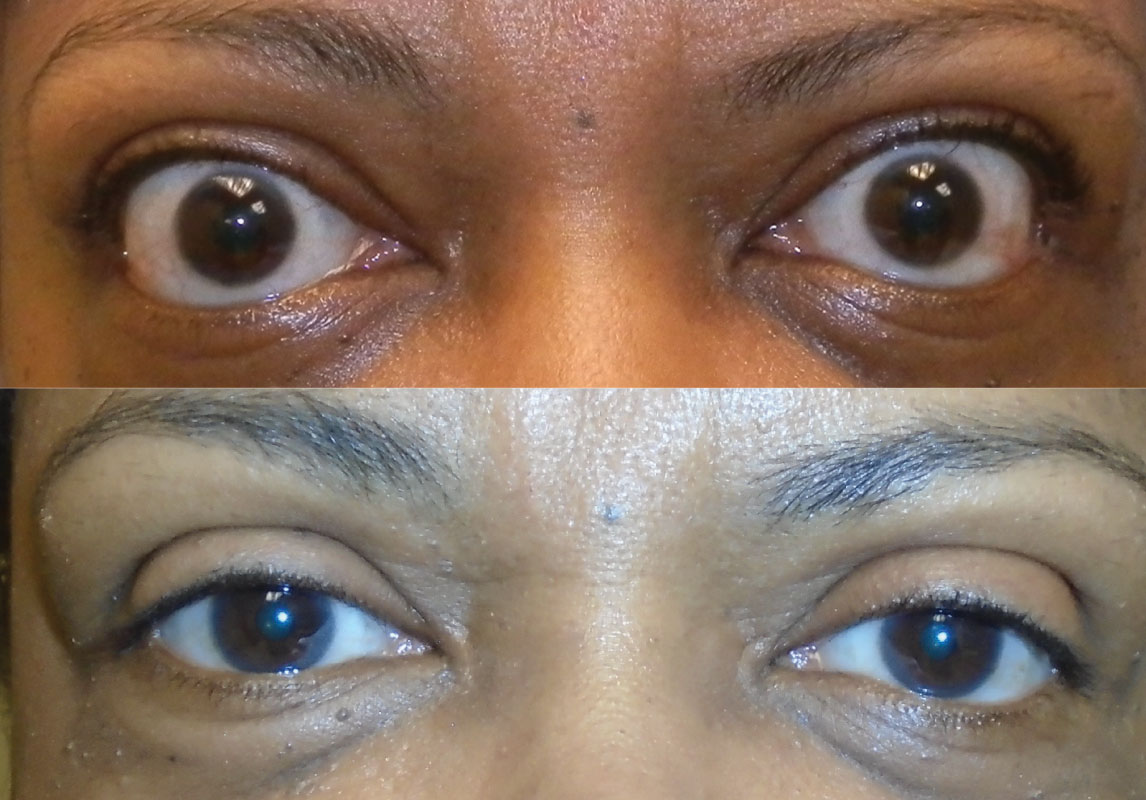 |
|
Before (above) and after (below) orbital decompression of a patient in the stable, inactive phase. Photo: Bobby Saenz, OD. Click image to enlarge. |
In a new AJO study analyzing data from the Intelligent Research in Sight (IRIS) Registry, researchers looked through records of patients with Graves’ disease to measure instances of orbital decompression, strabismus surgery and eyelid recession. The retrospective study was meant to describe the association of each of these with smoking status.
Of the 87,923 thyroid eye disease (TED) patients included, current smokers displayed a greater five-year probability and were at greater risk of a need for surgery compared to those who have never smoked. Probability was almost double that of non-smokers for each procedure: 3.7% vs. 1.9% for orbital compression, 4.6% vs. 2.2% for strabismus surgery and 4.1% vs. 2.6% for eyelid recession. Former smokers similarly showed a higher risk of needing each surgery type for TED, but their risk was a lower level than for current smokers.
As the researchers of the study explain, “the findings in this large registry-based analysis support the existing literature on the association between smoking and TED and provide novel insight on the potential impact of smoking cessation on lowering the risk of surgical intervention for TED at the population-level.”
Echoing this sentiment, they further explain that smoking is described as a modifiable risk factor for TED proportionate to the number of cigarettes smoked a day, with a higher instance of ocular involvement in Graves’ disease patients who also smoke. Those smokers generally display even more severe TED and have worse risk of outcomes after receiving radioiodine or immunosuppressive treatment.
As a possible explanation of the mechanisms at play for this connection, the researchers point to orbital fibroblasts’ role in TED pathogenesis. Orbital fibroblasts express antigens responding to circulating antibodies, and activation of the fibroblasts causes connective tissue to remodel, thus resulting in periorbital tissue edema. Smoking, which increases oxidative stress–mediated orbital fibroblast production, generates reactive oxygen species. The cessation of smoke inhalation is thought to reverse some of these processes.
In addition to greater risk of surgical intervention for smokers, the researchers found that women were at higher risk of Graves’ disease, representing the majority of patients included, making up 81%. While the role of sex in relation to thyroid eye disease is not completely agreed upon, this study found that females were at lower risk for orbital decompression and strabismus surgery. Despite this, there was not an observed interaction between sex and smoking status of the included patients. The researchers thus suggest that while female sex may increase development of Graves’ disease and TED, smoking is what is responsible for an increased risk of surgical intervention in such patients.
The application of this information is apparent, as the authors of the study suggest that “physicians should be aware of the long-term burden of surgical disease associated with smoking in TED and counsel active smokers with Graves’ disease on the benefits of smoking cessation.”
Oke I, Reshef ER, Elze T, et al. Smoking is associated with a higher risk of surgical intervention for thyroid eye disease in the IRIS Registry. Am J Ophthalmol. 2023. [Epub ahead of print]. |

